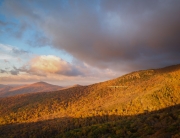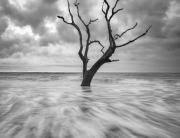Three things that I look for when photographing landscapes are a dramatic background, good light, and a solid foreground. In this post I want to focus on just the foreground. This is a part of a series on composition in which foreground plays a major role.
Foreground
The foreground is key to leading the viewer’s eye to the background. Keeping the viewers interest is paramount and one of the best ways to do that is to help lead the eye through the photograph. An additional way to enhance your image is to generate the sense of three dimensions (3D) for the viewer. A strong foreground can help to give the image a sense of 3D.
The foreground element doesn’t have to be anything special, but it should be clearly noticeable and it should stand out from the background. An object with leading lines pointing towards the background makes a great foreground element.
Generally I look for smaller foreground objects and place them close to a rule of thirds intersection. Larger objects need to be very interesting in order to work effectively, and then placing them more in the center helps the final image.
A Strong Foreground Example
The image below is from Kiawah Beach as a storm rolled through the area. It is greatly enhanced by the tree limb as a foreground element that stands out distinctly against the watery beach. This element is the first thing you see when you look at the image and it leads the eye down the beach and into the very dramatic stormy sky at sunset. The high contrast of the tree limb makes it really jump out and really works for me as a strong foreground.
Let me know how you choose your foreground elements in the comments below.






























